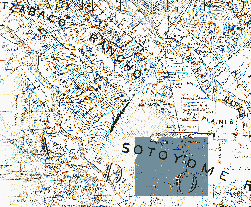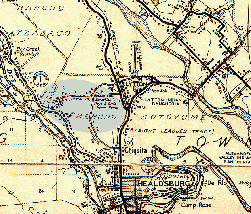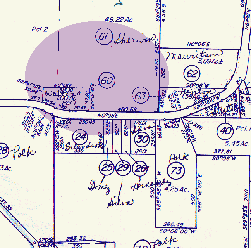
|
|
|
Captain Henry Delano Fitch was a native of New Hampshire and came to California in 1833 or so, where he commanded merchant ships that traded along the California coast. While in San Diego in 1837 or so, he became smitten with Josefa Carillo. Jose Maria Echeandia, the Governor at the time, was also interested in the girl, and prevented her and Fitch from marrying. They eloped to South America, returning almost a year later with an infant son. General Mariano Vallejo, who first settled the lands north of San Francisco soon married Josefa's younger sister, and H. D. Fitch became his brother-in-law. This would result in Fitch's acquisition of the land grant known as Rancho Sotoyome, consisting of 11 square leagues - more than 48,800 acres. Fitch promptly hired Cyrus Alexander to manage the Rancho. Alexander was given 9000 acres as payment for his services, and chose the magnificent valley east of the Russian River that now bears his name. Fitch died in 1848, and after the United States Government legitimized the early land grants in 1858, his widow began auctioning parcels of the property in order to meet her family's expenses. In 1860 an American sea captain acquired a large tract north of what would become the town of Healdsburg. The property extended from the northern boundaries of Healdsburg to the southern boundaries of Geyserville, and from the Russian River to the Dry Creek. The sea captain's name was William H. Litton. Litton and his partners decided to capitalize on the improved transportation. They built a resort hotel in 1875 on a site that contains both a soda spring and a sweetwater spring. The hotel, able to accommodate 150 guests became known as Litton Springs, the nearby train depot was called Litton Station. In 1887, Captain Litton died from head injuries sustained in a fall from a buggy, and his family, no longer interested in maintaining the resort, allowed it to become a military academy for the sons of wealthy Bay Area families. Three years later, in 1890, despite winning a lawsuit against him for water rights, Mrs. Litton lost control of the property to James Donahue, who was developing Litton Township, just east of the railroad he built. Ironically, he died that year. As part of the settlement of his estate, the property was sold to Charles H. Montgomery in 1893, who sold it to a Dr. Burke from Oakland, who planned to operate a sanitarium on the site. Later, in 1898, a portion of the property - 712 acres - was sold to George S. Montgomery and A. W. Dennett, a restaurateur from San Francisco. They planned to keep the sanitarium concept alive, augmenting its attraction with Bible courses. Somehow, whether by accident or design, the spelling of the property's name was changed around this time by the county from "Litton" to "Lytton". In the early 1900s, the Salvation Army purchased some 1600 acres of the property, and opened an orphanage for boys and girls. Their ownership continues to today. The ownership of the western portion of the tract is difficult to trace, but it was eventually purchased by the Frost family, who farmed it for decades. In 1970, they sold it to a fellow by the name of Richard Sherwin. |
| Main Index Page | Email | Site Index
|
© Gang of Pour.com |





